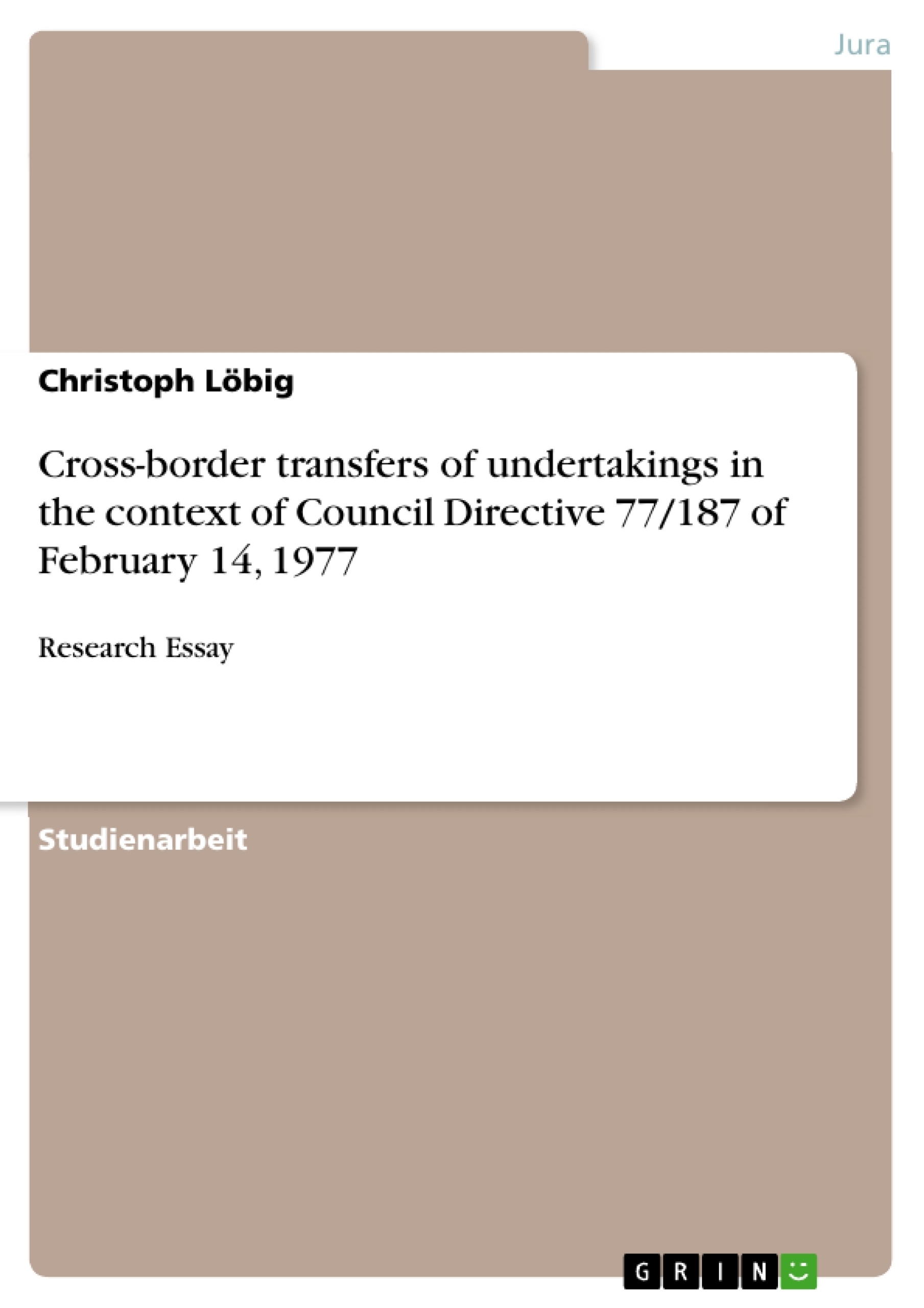While mergers, acquisitions and outsourcing processes were mainly confined to the borders of individual Member States between the late 1960s and mid-1970s, the internationalisation of capital markets, the abolition of obstacles to trade, the improved infrastructure and the widespread supply of qualified labour entailed a significant rise in the number of cross-border transfers of undertakings during the second half of the 1980s and from 1995 onwards. Between 2002 and 2006, offshoring and delocalization operations from one Member State to another increased by 800 percent according to the European Restructuring Monitor.
The European Commission ascribes this trend to the enlargement of the European Union, the consolidation of the internal market and the introduction of facilitating legal measures and expects the increase of transnational transfers of undertakings to continue. The purpose of this essay is to investigate in how far the Directive could be amended to deal with the specific case of cross-border transfers of undertakings.
In order to provide a sophisticated solution, I will first outline the relevant scenarios in which cross-border transfers of undertakings may possibly occur in practice and discuss whether those cases are covered or if the Directive’s scope needs to be extended. Subsequently, I will check whether the definition of transfers of undertakings is broad enough to apply to cross-border transfers or if it is necessary to introduce amendments in order to safeguard workers’ interests sufficiently. The main focus of this paper, however, lies on the analysis of the appropriateness of the three substantive pillars of protection in cross-border scenarios. Eventually, I will briefly address problems in relation to conflicts of jurisdictions before I give a personal recommendation.
Inhaltsverzeichnis
- A. Introduction
- B. Scenarios of cross-border transfers of undertakings.
- C. Scope of the Acquired Rights Directive
- D. Definition of transfers of undertakings
- E. Appropriateness of the three pillars of protection for transnational Transfers...
- I. Suitability of the first pillar of measures of employment protection .....
- 1. Transfer of contractual rights and obligations
- 2. Transfer of statutory rights and obligations
- 3. Transfer of rights and obligations deriving from collective bargaining agreements
- II. Suitability of the second pillar of measures of employment protection
- III. Suitability of the third pillar of measures of employment protection
- F. Jurisdiction of courts in cross-border scenarios.
- G. Conclusion
Zielsetzung und Themenschwerpunkte
Dieser Forschungsaufsatz befasst sich mit der Auslegung und Anwendung der Richtlinie 77/187/EWG im Kontext grenzüberschreitender Unternehmenstransfers. Die Arbeit analysiert die Notwendigkeit einer Anpassung der Richtlinie, um den besonderen Herausforderungen gerecht zu werden, die sich bei grenzüberschreitenden Transfers von Unternehmen stellen.
- Anpassung der Richtlinie 77/187/EWG an grenzüberschreitende Transfers
- Schutz der Arbeitnehmerrechte bei Unternehmenstransfers
- Jurisdiktionsfragen im grenzüberschreitenden Kontext
- Anwendbarkeit der drei Säulen des Arbeitnehmerschutzes
- Definition des Transfers von Unternehmen
Zusammenfassung der Kapitel
- A. Introduction: Dieses Kapitel liefert eine Einführung in das Thema der grenzüberschreitenden Unternehmenstransfers und die Relevanz der Richtlinie 77/187/EWG für den Schutz der Arbeitnehmerrechte.
- B. Scenarios of cross-border transfers of undertakings: Hier werden verschiedene Szenarien von grenzüberschreitenden Unternehmenstransfers vorgestellt, um die spezifischen Herausforderungen zu verdeutlichen, die sich bei solchen Transfers ergeben.
- C. Scope of the Acquired Rights Directive: Dieses Kapitel untersucht den Geltungsbereich der Richtlinie 77/187/EWG und ihre Relevanz für den Schutz der Arbeitnehmerrechte bei Unternehmenstransfers.
- D. Definition of transfers of undertakings: Hier wird die Definition des Transfers von Unternehmen im Rahmen der Richtlinie 77/187/EWG analysiert und die Kriterien für die Anwendung der Richtlinie erläutert.
- E. Appropriateness of the three pillars of protection for transnational Transfers: Dieses Kapitel bewertet die Angemessenheit der drei Säulen des Arbeitnehmerschutzes (Vertragsrechte, gesetzliche Rechte und Rechte aus Tarifverträgen) für grenzüberschreitende Unternehmenstransfers.
- F. Jurisdiction of courts in cross-border scenarios: Dieses Kapitel behandelt die Frage der Gerichtszuständigkeit in grenzüberschreitenden Transferszenarien und die Rechtsgrundlagen für die Zuständigkeit der Gerichte.
Schlüsselwörter
Die wichtigsten Schlüsselwörter und Themen dieses Forschungsaufsatzes sind grenzüberschreitende Unternehmenstransfers, Richtlinie 77/187/EWG, Arbeitnehmerrechte, Schutzbestimmungen, Jurisdiktionsfragen, Arbeitnehmerüberlassung, Betriebsübergang, Rechtsharmonisierung und europäisches Arbeitsrecht.
- Arbeit zitieren
- Christoph Löbig (Autor:in), 2008, Cross-border transfers of undertakings in the context of Council Directive 77/187 of February 14, 1977, München, GRIN Verlag, https://www.grin.com/document/163865



